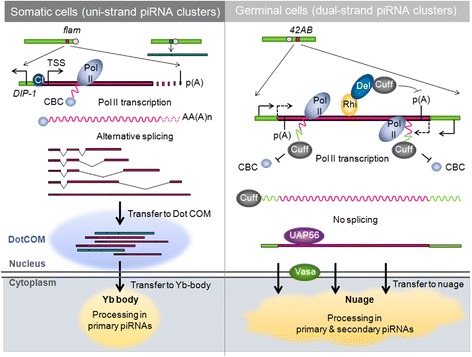Figure 1.

Synthesis and fate of piRNA precursor transcripts in Drosophila ovarian somatic cells versus germinal cells. In somatic follicle cells (left) most piRNA clusters are uni-strand. The flam locus (red square) spans over approximately 200 kb and is located at the pericentromeric region of the X-chromosome, downstream of the DIP1 gene. flam transcription is initiated from an RNA polymerase II promoter containing a transcription start site (TSS) at position X:21,502,918. The transcription factor Cubitus interruptus (Ci) activates the transcription. Capped (blue circle) and polyadenylated flam transcripts, undergo differential alternative splicing to generate diverse RNA precursors that all share the first exon at their 5′ end. flam piRNA precursors, together with transcripts coming from other somatic piRNA clusters (dark green square), are addressed to a single nuclear structure designated Dot COM (blue shadow) in ovarian follicle cells. Dot COM is localized at the nuclear membrane and faces a cytoplasmic Yb body where piRNA precursors are proposed to be transferred and processed. In germinal cells (right) most piRNA clusters are dual-strand, such as the 42AB locus (red square) located on chromosome 2R. Dual-strand cluster expression depends on Rhi, Del and Cuff, which repress RNA polymerase II termination leading to a presumed read-through transcription of piRNA clusters initiated at neighboring genes. Cuff is also thought to compete with the cap binding complex (CBC) to bind uncapped nascent RNAs, to prevent RNA capping and splicing. UAP56 binds dual-strand-cluster transcripts and escorts them to the nuclear periphery where cytoplasmic Vasa may transfer them to cytoplasmic nuage where germinal piRNAs are processed.
